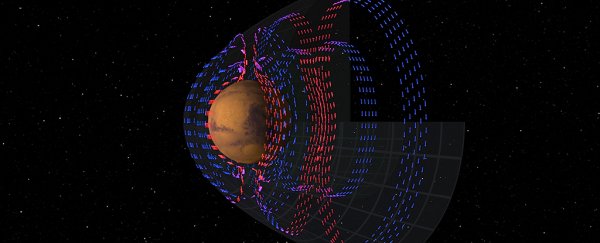Unlike Earth, Mars doesn't have a global magnetic field to protect it from the rigours of space weather – but it does have spots of local, induced magnetism.
Now, researchers have been able to create an incredible, detailed map of the electric currents that are responsible for shaping these magnetic fields.
It gives scientists a much greater understanding of how Mars might have lost much of its atmosphere over the course of billions of years, as well as how interactions between the solar winds and Mars' magnetosphere are playing out today.
As you can see from the video embedded below, the team working with the Mars Atmosphere and Volatile Evolution (MAVEN) spacecraft have been able to produce some jaw-dropping visualisations from the captured magnetic readings. Previously hidden flows of energy are suddenly visible in full colour.
"These currents play a fundamental role in the atmospheric loss that transformed Mars from a world that could have supported life into an inhospitable desert," says planetary scientist Robin Ramstad, from the University of Colorado, Boulder.
"We are now currently working on using the currents to determine the precise amount of energy that is drawn from the solar wind and powers atmospheric escape."
The team analysed five years of data from MAVEN to come up with their maps, which show electrical currents creating a nested, double-loop structure around Mars, wrapping all the way around both the day and night side of the planet.
These currents interact with the incoming solar wind, causing it to envelop Mars and flow around it like spaghetti noodles around a basketball. The findings build on the discovery of the planet's unique magnetic tail, spotted by MAVEN three years ago.
What's also interesting for the researchers is the detail of the interplay between the solar winds and the electric currents, and how energy is transferred between the upper atmosphere, the magnetosphere, and the solar wind.
"Mars' atmosphere behaves a bit like a metal sphere closing an electric circuit," says Ramstad. "The currents flow in the upper atmosphere, with the strongest current layers persisting at 120-200 kilometres (75-124 miles) above the planet's surface."
"With a single elegant operation, the strength and paths of the currents pop out of this map of the magnetic field."
Besides making for some stunning visualisations, the map of electric currents that the researchers have put together should be able to tell us more about how the atmosphere of Mars continues to get stripped away, and how these interactions may have evolved over the course of the planet's history.
Scientists still have a lot of questions about what happened to Mars' once thick, busy atmosphere – and about how we might one day make it habitable again.
There's lots more to come from this data, and from MAVEN.
Understanding the behaviour of the magnetic field around the Red Planet has the potential to give us some big clues about why its atmosphere is now so different from our own – and indeed from Venus, which also has an induced magnetosphere.
"If you want to understand how the atmosphere of Mars and Venus are so different from the Earth's, and why they're different from each other despite both being non-magnetised, we need to understand their induced magnetospheres first," says Ramstad.
The research has been published in Nature Astronomy.
